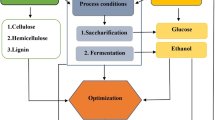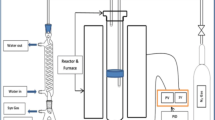Abstract
This study comparatively evaluates the modelling efficiency of the Response Surface Methodology (RSM) and the Artificial Neural Network (ANN). Twenty-nine biohydrogen fermentation batches were carried out to generate the experimental data. The input parameters consisted of a concentration of molasses (50–150 g/l), pH (4–8), temperature (35–40 °C) and inoculum concentration (10–50 %). The obtained data were used to develop the RSM and ANN models. The ANN model was a committee of networks with a topology of 4-(6-10)-1 structured on multilayer perceptrons. RSM and ANN models gave R 2 values of 0.75 and 0.91, respectively, with predicted optimum conditions of 150 g/l, 8 and 35 °C for molasses, pH and temperature, respectively, with differences in inoculum concentrations (10.11 and 15 %) for RSM and ANN, respectively. Upon validation, 15.12 and 119.08 % prediction errors on hydrogen volume were found for ANN and RSM, respectively. These findings suggest that ANN has greater accuracy in modelling the relationships between the considered process inputs for fermentative biohydrogen production and thus, is more reliable to navigate the optimization space.








Similar content being viewed by others
References
Das D, Veziroglu TN (2001) Hydrogen production by biological processes: a survey of literature. Int J Hydrog Energy 26:13–28
Nath K, Das D (2004) Improvement of fermentative hydrogen production: various approaches. Appl Microbiol Biotechnol 65:520–529
Pandu K, Joseph S (2012) Comparisons and limitations of biohydrogen production processes: a review. Int J Adv Eng Technol 2(1):342–356
Salerno MB, Park W, Zuo Y, Logan BE (2006) Inhibition of biohydrogen production by ammonia. Water Res 40(6):1167–1172
Escamilla-Alvarado C, Rios-Leal E, Ponce-Noyola MT, Poggi-Varaldo HM (2012) Gas biofuels from solid substrate hydrogenic–methanogenic fermentation of the organic fraction of solid municipal wastes. Process Biochem 47(11):1572–1587. doi:10.1016/j.procbio.2011.12.006
Prakasham RS, Sathish T, Brahmaiah P, SubbaRao C, SreenivasRao R, Hobbs PJ (2009) Biohydrogen production from renewable agri-waste blend: optimization using mixer design. Int J Hydrog Energy 34:6143–6148
Mandenius C, Brundin A (2008) Review: biocatalysts and bioreactor design—bioprocess optimization using design-of-experiments methodology. Biotechnol Progress 24:1191–1203
Desai KM, Survase SA, Saudagar PS, Lele SS, Singhal RS (2008) Comparison of artificial neural network (ANN) and response surface methodology (RSM) in fermentation media optimization: case study of fermentative production of scleroglucan. Biochem Eng J 41:266–273
Gueguim Kana EB, Oloke JK, Lateef A, Adesiyan MO (2012) Modelling and optimization of biogas production on saw dust and other co-substrates using artificial neural network and genetic algorithm. Renew Energy 46:276–281
Gueguim Kana EB, Oloke JK, Lateef A, Kana AFD (2010) Pro-optimizer: a novel web-enabled optimization engine for microbial fermentations. Biotechnol Biotechnol Eq 24(4):2137–2141
Gueguim Kana EB, Oloke JK, Lateef A, Oyebanji A (2012) Comparative evaluation of artificial neural network coupled genetic algorithm and response surface methodology for modelling and optimization of citric acid production by Aspergillus niger MCBN297. Chem Eng Trans 27:397–402
Wang J, Wan W (2009) Optimization of fermentative hydrogen production process using genetic algorithm based on neural network and response surface methodology. Int J Hydrog Energy 34:255–261
Wang X, Jin B (2009) Process optimization of biological hydrogen production from molasses by a newly isolated Clostridium butyricumW5. J Biosci Bioeng 107(2):138–144
Chong M, Rahman NAA, Rahim RA, Aziz SA, Shirai Y, Hassan MA (2009) Optimization of biohydrogen production by Clostridium butyricumEB6 from palm oil mill effluent using response surface methodology. Int J Hydrog Energy 34:7475–7482
Wang X, Jin B, Mulcahy D (2008) Impact of carbon and nitrogen sources on hydrogen production by a newly isolated Clostridium butyricumW5. Int J Hydrog Energy 33:4998–5005
Prakasham RS, Sathish T, Brahmaiah P (2011) Imperative role of neural networks coupled genetic algorithm on optimization of biohydrogen yield. Int J Hydrog Energy 36:4332–4339
Frankfort-Nachmias C, Leon-Guerrero A (2011) Social statistics for a diverse society, 6th edn. Pine Forge, USA, pp 1–537
Sexton RS, Dorsey RE, Johnson JD (1999) Optimization of neural networks: a comparative analysis of the genetic algorithm and simulated annealing. Eur J Oper Res 114:589–601
Lin CY, Lin CY, Wu JH, Chen CC (2007) Effect of a thermal pretreatment of influent on the fermentative hydrogen production from molasses. J Environ Eng Manage 17(2):117–122
Kotay SM, Das D (2006) Microbial hydrogen production with Bacillus coagulans IIT-BT S1 isolated from anaerobic sewage sludge. Bioresour Technol 1–8
Khanal SK, Chen WH, Li L, Sung S (2004) Biological hydrogen production: effects of pH and intermediate products. Int J Hydrog Energy 29:1123–1131
Kawagoshi Y, Hino N, Fujimoto A, Nakao M, Fujita Y, Sugimura S, Furukawa K (2005) Effect of inoculum conditioning on hydrogen fermentation and pH effect on bacterial community relevant to hydrogen production. J Biosci Bioeng 100(5):524–530
Chong M, Sabaratnam V, Shirai Y, Hassan MA (2009) Review: biohydrogen production from biomass and industrial wastes by dark fermentation. Int J Hydrog Energy 34:3277–3287
Kapdan IK, Kargi F (2006) Bio-hydrogen production from waste materials. Enzym Microb Biotechnol 38:569–582
YossanS O-TS, Prasertsan P (2012) Effect of initial pH, nutrients and temperature on hydrogen production from palm oil mill effluent using thermotolerant consortia and corresponding microbial communities. Int J Hydrog Energy 37:13807–13814
Adams MWW, Mortenson LE (1984) The physical and catalytic properties of hydrogenase II of Clostridium pasteurianum: a comparison with hydrogenase I. 259 (11):7045–7055
Bakonyi P, Nemestóthy N, Lövitusz Ѐ, Bélafi-Bakό K (2011) Application of Plackett–Burman experimental design to optimize biohydrogen fermentation by E. coli (XL1-BLUE). Int J Hydrog Energy 36:13949–13954
Veena T, Tiwari KL, Quraishi A, Jadhav SK (2012) Biohydrogen production from rice mill effluent. J Appl Sci Environ Sanit 7(4):237–240
Acknowledgments
The financial assistance of the National Research Foundation (NRF) towards this research is hereby acknowledged. Opinions expressed and conclusions arrived at, are those of the authors and are not necessarily to be attributed to the NRF.
Author information
Authors and Affiliations
Corresponding author
Rights and permissions
About this article
Cite this article
Whiteman, J.K., Gueguim Kana, E.B. Comparative Assessment of the Artificial Neural Network and Response Surface Modelling Efficiencies for Biohydrogen Production on Sugar Cane Molasses. Bioenerg. Res. 7, 295–305 (2014). https://doi.org/10.1007/s12155-013-9375-7
Published:
Issue Date:
DOI: https://doi.org/10.1007/s12155-013-9375-7




